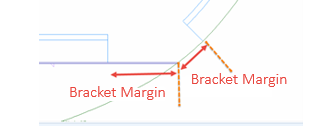Settings
Construction > Brackets > Settings
Bracket Margin
The axes needed in the calculation of the bracket contour are derived from bracket relations. The relations are extended to the box around a particular relation. This setting defines the distance required to determine the intersection between the two X-axes of the coordinate systems when a profile or shell frame has been selected.
If the distance between two related profiles or shell frames exceeds the value set here, a bracket will not be created. The default value is 500 mm.
The value defines how much the minimal box is extended around the relation in all directions before the axes are derived. This is necessary to find the origin of the bracket in the case of two profiles with a certain space between them, for example. Also, brackets with an overlap are only possible when the value of this setting is larger than the overlap value.

Slanted Plane Shift Factor
Set the threshold for the shift that the system uses when it adjusts the plane of a bracket connecting two profiles which are not parallel to each other (or shell frames, face plates or pillars).
Adjustment may be needed because it can happen that one of the arms of the bracket is not fully connected to one of the profiles, and thus the bracket does not properly support the profile. To fix the gap in the connection, the system automatically adjusts the plane of the bracket by shifting one of its corners so that the bracket properly touches the profile. See Automatic adjustment of the bracket plane for more detailed information.
The setting value is a factor that is multiplied by the profile body thickness. The result of the multiplication is the threshold for the shift. The default value for the factor is 1, which means that the threshold for the shift equals the profile body thickness.

Slanted Plane Shift Factor set to 2. The resulting shift is 2 x profile thickness.
Note: If the shift of the bracket's corner exceeds the threshold, the system shows a warning, but still creates the bracket. In this case it may be necessary to make adjustments to the construction.